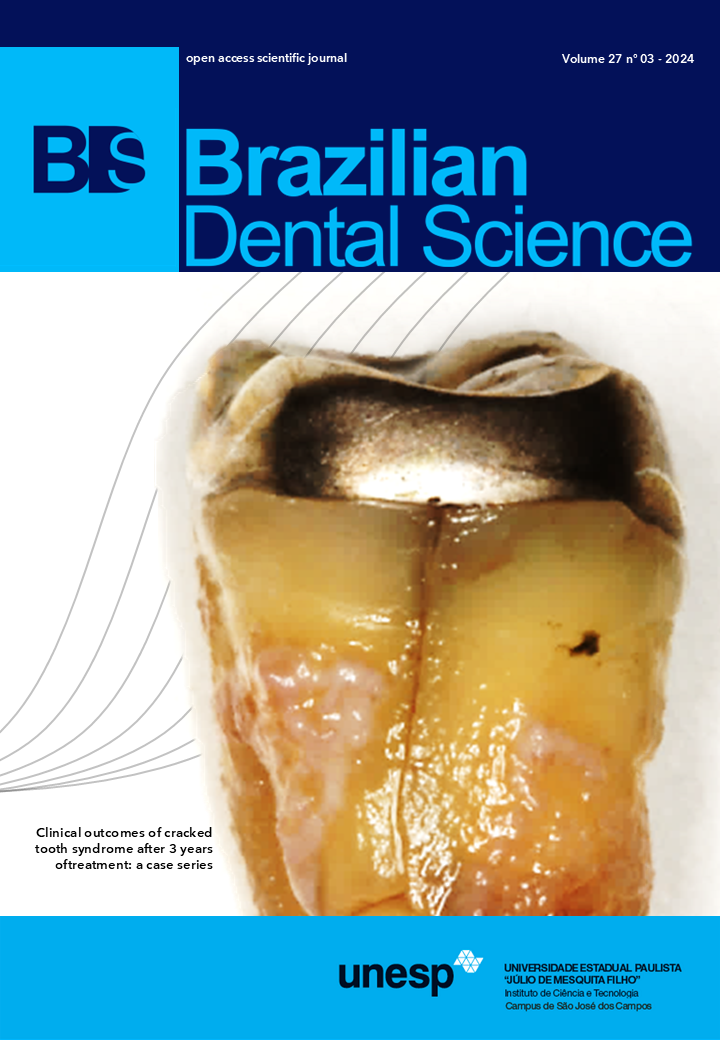Effect of repeated pressing on the fracture resistance of heat-pressed glass ceramic crowns
DOI:
https://doi.org/10.4322/bds.2024.e4267Resumo
Objective: This study examines the impact of re-pressing four different glass ceramic materials on the fracture resistance (FR) of single crowns. Material and Methods: Fifty-six heat-pressed crowns were fabricated from four glass ceramic materials. Crowns were divided into 4 groups (n=14): lithium disilicate IPS Emax press LDS1, lithium disilicate LiSi press LDS2, zirconia reinforced lithium silicate Celtra press ZLS, and zirconia reinforced lithium disilicate Vita Ambria ZLDS. Two subgroups (n=7) were created for each group. Group (P) crowns were made from fresh ingots. Group (R) crowns were made from re-pressed buttons. Samples were then subjected to fracture resistance (FR). Failure load was indicated by an audible crack and verified by a dramatic decline in the load-deflection curve, as recorded using computer software. The load under which crowns fractured was ultimately recorded in Newtons (N). The properties of the glass ceramic crowns were characterized before and after re-pressing by scanning electron microscope (SEM), X-ray diffraction (XRD), and energy dispersive X-ray (EDAX). Results: Numerical data were tested for normality using the Kolmogorov-Smirnov and Shapiro-Wilk statistical tests. The results indicated that ceramic type had a significant effect on FR (p-value < 0.001). The thermal technique used also had a significant effect on FR (p-value = 0.036). Group LDS1 showed the highest FR (1765.8N), while Group ZLDS showed the lowest FR (1247N). When comparing (P) to (R) groups, XRD revealed no variation in the primary crystalline structure. EDAX revealed no difference in chemical makeup between groups. Conclusion: Re-pressing improves the studied glass ceramics crowns’ resistance to fracture.
KEYWORDS
Flexural strength; Glass ceramics; Lithium disilicate; Recycling; Zirconium oxide.
Downloads
Downloads
Publicado
Como Citar
Edição
Seção
Licença
TRANSFERÊNCIA DE DIREITOS AUTORAIS E DECLARAÇÃO DE RESPONSABILIDADE
Toda a propriedade de direitos autorais do artigo "____________________________________________________________________" é transferido do autor(es) para a CIÊNCIA ODONTOLÓGICA BRASILEIRA, no caso do trabalho ser publicado. O artigo não foi publicado em outro lugar e não foi submetido simultaneamente para publicação em outra revista.
Vimos por meio deste, atestar que trabalho é original e não apresenta dados manipulados, fraude ou plágio. Fizemos contribuição científica significativa para o estudo e estamos cientes dos dados apresentados e de acordo com a versão final do artigo. Assumimos total responsabilidade pelos aspectos éticos do estudo.
Este texto deve ser impresso e assinado por todos os autores. A versão digitalizada deverá ser apresentada como arquivo suplementar durante o processo de submissão.




























